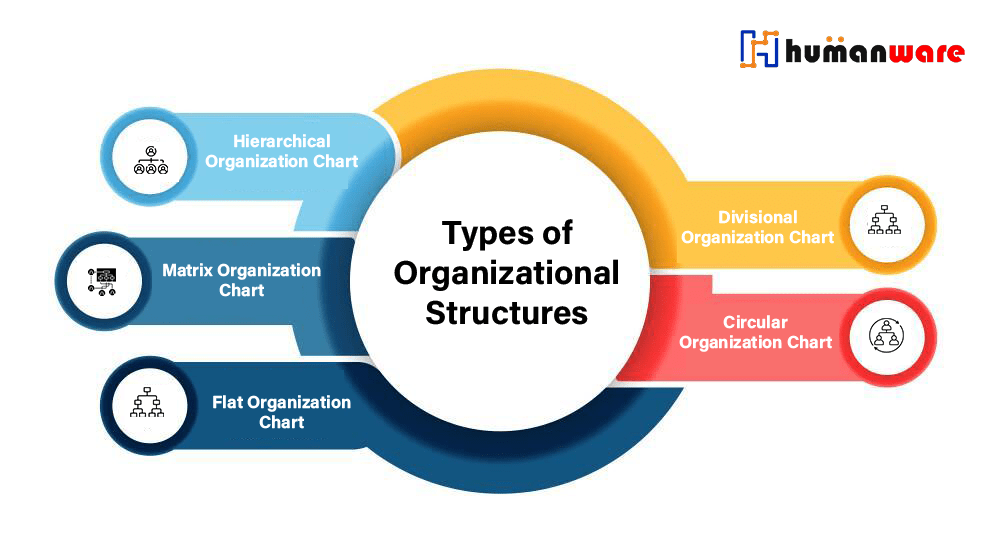
Types of Organizational Structures Every HR Must Know About
An organizational chart is a visual representation of a company's internal structure. It helps companies define roles, simplify communication, and improve efficiency. Choosing the right type of organizational chart is essential for effectively managing teams and projects.
1. Hierarchical Organization Chart
A hierarchical organizational chart visually represents the structure of an organization in a top-down format, with authority and responsibility flowing from higher levels to lower levels. It typically starts with the top management (such as a CEO or director), then various levels of management, and finally the employees at the bottom.
Key Features:
- Clear Chain of Command – Shows reporting relationships between employees and managers.
- Defined Roles & Responsibilities – Each position has specific duties and authority.
- Departmental Division - Departments or teams are structured under respective managers.
- Top-Down Authority – Decision-making power flows from the top level downwards.
2. Matrix Organization Chart
A matrix organizational design is a structure in which employees have dual or multiple reporting relationships. Unlike a hierarchical structure, where each employee has a single supervisor, the matrix model combines functional and project competencies. This configuration is commonly used in complex and dynamic industries that require cross-functional collaboration, such as technology, construction, healthcare, and multinational corporations.
Key Features:
- Dual Reporting System – Employees report to both a functional manager (e.g., department head) and a project manager.
- Cross-Functional Teams – Encourages collaboration across different departments.
- Resource Optimization – Employees are assigned to projects based on expertise rather than hierarchy.
3. Flat Organization Chart
A flat organizational chart depicts a structure with few or no middle management levels between employees and senior management. It promotes decentralized decision-making, encouraging open communication and collaboration.
Key Features:
- Few or No Middle Managers – Employees have direct access to top executives or business owners.
- Decentralized Decision-Making – Employees are empowered to take initiative and make decisions.
- Broad Responsibilities – Roles are more flexible, and employees handle multiple tasks.
- Fast Communication – With fewer hierarchical barriers, information flows quickly.
4. Divisional Organization Chart
A divisional organizational chart represents a structure in which the organization is divided into semi-autonomous units, each focused on a specific product, service, market, or geographic region. Each division operates independently, using its own resources, such as human resources, marketing, finance, and operations, while the headquarters provides overall strategic direction.
Key Features:
- Self-Contained Units – Each division functions like a separate entity within the organization.
- Focus on Products/Markets – Divisions are structured around product lines, customer segments, or geographic regions.
- Independent Decision-Making – Divisions have their own management teams responsible for operations and profitability.
- Centralized Oversight – The top leadership (corporate HQ) oversees divisions but allows operational freedom.
5. Circular Organization Chart
The circular organizational design represents a structure in which power and communication flow in a circular fashion rather than in a top-down hierarchy. In this model, leadership is at the center, surrounded by employees at different levels in outer rings, emphasizing cooperation and interconnectedness rather than strict hierarchy.
Key Features:
- Leadership at the Center – Top executives or decision-makers are placed at the core, with different levels of employees positioned in outer circles.
- Encourages Collaboration – Unlike hierarchical charts, it focuses on teamwork and open communication.
- Decentralized Decision-Making – Employees have more autonomy, and ideas flow freely across the organization.
- Flexible and Adaptive – Ideal for companies that emphasize innovation and agility.
Conclusion
Choosing the right organizational chart depends on the size, industry, and goals of your business. A well-designed organizational chart can improve communication, increase efficiency, and support business growth.